Jockey
A jockey is someone who rides horses in horse racing or steeplechase racing, primarily as a profession. The word also applies to camel riders in camel racing.
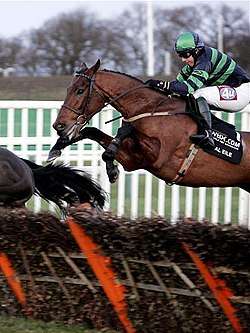
Etymology
The word is by origin a diminutive of jock, the Northern English or Scots colloquial equivalent of the first name John, which is also used generically for "boy" or "fellow" (compare Jack, Dick), at least since 1529. A familiar instance of the use of the word as a name is in "Jockey of Norfolk" in Shakespeare's Richard III. v. 3, 304.
In the 16th and 17th centuries the word was applied to horse-dealers, postilions, itinerant minstrels and vagabonds, and thus frequently bore the meaning of a cunning trickster, a "sharp", whence the verb to jockey, "to outwit", or "to do" a person out of something. The current meaning of a person who rides a horse in races was first seen in 1670.[1]
Another possible origin is the Gaelic word eachaidhe, a "horseman", (pronounced YACH-ee-yuh in late medieval times, with the ch pronounced as in German).[2] The Irish name Eochaid (YO-ked) is related to each (yek) "horse" and is usually translated as "horse rider". This is phonetically very similar to jockey.
Physical characteristics
Jockeys must be light to ride at the weights which are assigned to their mounts. There are horse carrying weight limits that are set by racing authorities. The Kentucky Derby, for example, has a weight limit of 126 lb (57 kg) including the jockey's equipment. The weight of a jockey usually ranges from 108 to 118 lb (49 to 54 kg).[3] Despite their light weight, they must be able to control a horse that is moving at 40 mph (64 km/h) and weighs 1,200 lb (540 kg). Though there is no height limit for jockeys, they are usually fairly short due to the weight limits. Jockeys typically stand around 4 ft 10 in (147 cm) to 5 ft 6 in (168 cm).[3]
Role
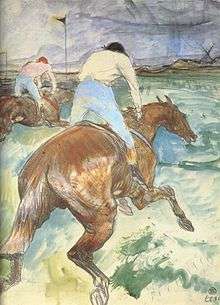
Jockeys are normally self employed, nominated by horse trainers to ride their horses in races, for a fee (which is paid regardless of the prize money the horse earns for a race) and a percentage of the purse winnings. In Australia, employment of apprentice jockeys is in terms of indenture to a master (a trainer); and there is a clear employee-employer relationship. When an apprentice jockey finishes their apprenticeship and becomes a "fully fledged jockey", the nature of their employment and insurance requirements change because they are regarded as "freelance", like contractors. Jockeys often cease their riding careers to take up other employment in racing, usually as trainers. In this way the apprenticeship system serves to induct young people into racing employment.
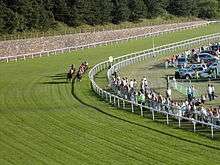
Jockeys usually start out when they are young, riding work in the morning for trainers, and entering the riding profession as apprentice jockeys. It is normally necessary for an apprentice jockey to ride a minimum of about 20 barrier trials successfully before being permitted to ride in races. An apprentice jockey is known as a "bug boy" because the asterisk that follows the name in the program looks like a bug.[4] All jockeys must be licensed and usually are not permitted to bet on a race. An apprentice jockey has a master, who is a horse trainer, and the apprentice is also allowed to "claim" weight off the horse's back: in handicapped races, more experienced riders will have their horses given an extra amount of weight to carry, whereas a jockey in their apprenticeship will have less weight on their horse, giving trainers an incentive to hire these less-experienced jockeys. This weight allowance is adjusted according to the number of winners that the apprentice has ridden. After a four-year indentured apprenticeship, the apprentice becomes a senior jockey[5] and usually develops relationships with trainers and individual horses. Sometimes senior jockeys are paid a retainer by an owner which gives the owner the right to insist the jockey ride their horses in races.
Racing modeled on the English Jockey Club spread throughout the world with colonial expansion.
Racing colors
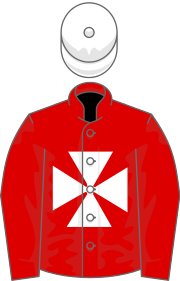
The colors worn by jockeys in races are the registered "colors" of the owner or trainer who employs them. The practice of riders wearing colors probably stems from medieval times when jousts were held between knights. However, the origins of racing colors of various patterns may have been influenced by racing held in Italian city communities since medieval times. Such traditional events are still held on town streets and are known for furious riding and the colorful spectacle they offer.[6]
While the term "silks" is used in the United States to refer to racing colors, technically "silks" are the white breeches and bib, stock or cravat. Obtaining them is a rite of passage when a jockey is first able to don silken pants and colors in their first race ride. At one time silks were invariably made of silk chosen for being a lightweight fabric, though now synthetics are used instead. Silks and their colors are important symbols of loyalty and festivity.
Jockeys are superstitious. During some races, they prefer to wear certain colours because racers who wore those colours in those races previously have won more often than those who did not. On other occasions, such as when jockeys purchase or are given a new uniform, they often throw the silk on the ground, trample on it and soil it so as to ward off any similar misfortune during their next race. These aspects of jockey life contribute to the creation of a unique environment but also to understand the symbolic meanings that safety vests (worn under the silks to protect the torso areas) generate for these unique professionals.[7]
Many of the silks bear chequered patterns, polka dots, stripes or icons such as quatrefoils. The wearing of silks originated in the United Kingdom. They were first mentioned in 1515, and the current system was formally established in the 1700s. Horses are identified as they race by the colourful, traditional silk shirts and helmets their jockeys wear, these representing the horses’ owners. The colours need to be significantly different to serve this purpose and are registered by 99 each Australian state’s Principal Racing Authority (PRA).[8] The silks of famous jockeys, horses and owners can fetch high prices at auction, suggesting the esteem in which history and tradition are held in horse racing. Although Racing Australia requires that all jockeys wear approved helmets and safety vests, racegoers are unaware of this latter safety equipment as it is worn beneath the silks. Jockeys also wear a ‘skivvy’ under the silks. On race days the skivvy chosen is a lightweight mesh or microfibre bodysuit, sleeved or sleeveless, whereas, for track work, a more heavy-duty version may be worn. Summarising, during an Australian race day, jockeys must wear the following: the helmet (or skullcap), goggles, silks, vest, breeches, gloves, boots, saddle and girth and stirrups.
Awards
Various awards are given annually by organizations affiliated with the sport of thoroughbred racing in countries throughout the world. They include:
- Australia
- Canada
- United Kingdom
- United States
Risk factors
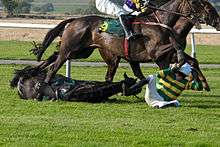
Horse racing is a sport where jockeys may incur permanent, debilitating, and even life-threatening injuries. Chief among them include concussion, bone fractures, arthritis, trampling, and paralysis. Jockey insurance premiums remain among the highest of all professional sports.[9] Between 1993 and 1996, 6,545 injuries occurred during official races for an injury rate of 606 per 1,000 jockey years.[10] In Australia race riding is regarded as being the second most deadly job, after offshore fishing. From 2002 to 2006 five deaths and 861 serious injuries were recorded.[6]
Eating disorders (such as anorexia) are also very common among jockeys, as they face extreme pressure to maintain unusually low (and specific) weights for men, sometimes within a five-pound (2.3 kg) margin.[11] The bestselling biography, Seabiscuit: An American Legend chronicled the eating disorders of jockeys living in the first half of the twentieth century. As in the cases of champion jockey Kieren Fallon and Robert Winston, the pressure to stay light has been blamed in part for jockeys suffering agonies of thirst from dehydration while racing.[12] Sports Dietitians Australia warns:"Dehydration and energy depletion may compromise concentration and coordination."[13] Indeed, recent research carried out in association with the Irish Turf Club measured the effects of rapid weight loss to make weight in professional and apprentice jockeys and found significant levels of dehydration; however, cognitive function was maintained, suggesting jockeys had become accustomed to performing in a dehydrated state and had potentially developed a preventative mechanism to enable them to perform under these conditions.[14]
In January 2016 it was announced that the International Concussion and Head Injury Research Foundation (ICHIRF) will run a new study. Named 'Concussion in Sport' it will be the first study to take a detailed look at the effects of concussion on sports people, including around 200 retired jockeys.[15]
Female jockeys
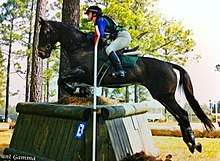
Based on American statistics, women comprise only 14 percent of working jockeys and ride only 10 percent of all race starts. Only two percent ride at the elite level of Triple Crown races.
Australia and New Zealand
During the 1850s amateur "ladies only" events held in Victoria, Australia, women were not permitted to ride as professional jockeys or on professional tracks.
Although women jockeys were barred from riding at registered race meetings, in the mid-1900s Wilhemena Smith rode as Bill Smith at north Queensland racecourses. She was nicknamed Bill Girlie Smith because she arrived on course with her riding gear on under her clothes and did not shower on course. It was only at the time of her death in 1975 that the racing world was officially told that Bill was really Wilhemena. Subsequent inquiries proved that William Smith was actually a woman who had been born Wilhemena Smith in a Sydney hospital in 1886.[16] In an era when women were clearly denied equality, she had become known as a successful jockey in Queensland country districts as 'Bill Smith'. Elizabeth Williams Berry rode in Melbourne and internationally, disguised as a boy and using the name, Jack Williams.[17]
During the late 1960s restrictions against female trainers were lifted in Australia, but female jockeys were still confined to "ladies only" events, which were held on non-professional tracks. The Victoria Racing Club in 1974 permitted women jockeys to be registered for professional "ladies only" events. In 1978 racing rules in New Zealand were amended to permit women jockeys.
In Australia Pam O'Neill and Linda Jones, in 1979, were the pioneers that forced jockey club officials to grant women the right to compete on an equal footing in registered races against men. They were unquestionably the first women jockeys to be licensed to ride in the metropolitan areas of Australia. Previously women had been riding against men in Australia at the unregistered "all-height" meetings. Pam created a world record for any jockey, male or female, when she rode a treble at Southport on her first day's riding.[18] Australia's top woman jockey, Bev Buckingham, became the first woman in the Southern Hemisphere to win 1,000 races. In 1998, in a fall at the Elwick Racecourse (Hobart), she broke her neck. She used a wheelchair for some time afterward, but regained her strength and mobility and was able to walk again without assistance.[19]
In 2004-05 Clare Lindop won the Adelaide jockeys' premiership and became the first woman to win a metropolitan jockeys' premiership in mainland Australia. Lisa Cropp won the 2006 New Zealand jockeys' premiership for the second consecutive season.[20] In 2005, Andrea Leek became the first woman to ride the winner of the Grand National Hurdle (4,300 m) at Flemington when she won aboard Team Heritage.[21]
In New Zealand women are over 40% of jockeys.[22]
Women today account for 17% of jockeys in Victoria. But, they receive only 10% of the rides, and are often overlooked in favour of male jockeys, especially in the cities.[23] In some regions of Australia about half of the apprentice jockey intakes are women.[21]
Michelle Payne became the first female jockey to win the Melbourne Cup on 3 November 2015.[24]
Great Britain and Ireland
Women were initially banned from racing under Jockey Club rules in Britain, though records indicate that women rode, disguised as men, as early as 1804.[25] In the Victorian era, Elizabeth Williams Berry of Australia, noted above, came to England and rode disguised as a man, continuing to use the name Jack Williams. To help her disguise, she smoked cigars and wore a bowler derby.[26] In the 20th century, after many years of debate, a series of a dozen races was approved for female jockeys in 1972. Meriel Patricia Tufnell overcame childhood disability to ride the novice Scorched Earth to victory in the first race, the Goya Stakes at Kempton Park on 6 May 1972.[27]
The first decade of the 21st century saw the profile of women jockeys rise considerably in British Flat racing. In 2005 Hayley Turner became Champion Apprentice rider, before becoming the first woman to ride 100 winners in a British season in 2008. Also in 2008, Kirsty Milczarek became the first woman to ride three winners at a single British race meeting, at Kempton in February. Milczarek rode 71 winners that year. This period saw the total number of female jockeys in British Flat racing rise significantly. Two further female jockeys have won the apprentice championship since Turner - Amy Ryan in 2012 and Josephine Gordon in 2016.[28] This change has not applied in National Hunt racing, though amateur riders Nina Carberry and Katie Walsh (sister of Ruby Walsh) have gained success in Ireland and ridden winners at the Cheltenham Festival.[29][30] In the 2010 National Hunt Chase at the Cheltenham Festival the winner and runner-up were both ridden by female jockeys. Katie Walsh was on board Poker de Sivola finishing ahead of Becauseicouldntsee which was ridden by Nina Carberry.[31]
On Boxing Day 2015 Lizzie Kelly became the first female jockey to win a grade one race in Britain, on Tea For Two in the Kauto Star Novices' Chase at Kempton Park.[32] Lizzie Kelly won another grade 1 in 2017. It was the Betway Bowl at the Grand National Festival, on Tea For Two. In the 2016/17 season Rachael Blackmore became the first female jockey to win the Irish Conditional Jockeys title.[33] In 2018 Lizzie Kelly became the first female professional jockey to ride a winner at the Cheltenham Festival. She rode Coo Star Sivola in the Ultima handicap chase. In 2019 Bryony Frost became the first female jockey to ride a grade 1 winner at the Cheltenham Festival. She rode Frodon in the Ryanair Chase.
United States and Canada
Eliza Carpenter (1851 – 1924) was an early African-American race horse owner. In Ponca City, Oklahoma, she trained horses for racing, becoming one of the few African-American stable owners in the West.[34] When dissatisfied with the way a race was going, she sometimes would ride her own horses as a jockey, winning some races. Recorded names of her horses include "Irish Maid", "Blue Bird", "Jimmy Rain", "Sam Carpenter", and "Little Brown Jug", the last of which she reportedly raced at Tijuana, Baja California.[34]
Anna Lee Aldred[35] (1921 – 2006) was given a license at age 18 in 1939 at Agua Caliente Racetrack in Tijuana, Mexico when officials were unable to find a rule that would bar women jockeys and she finished second by a nose in her first professional race. Hollywood stuntwoman Alice Van-Springsteen (1918 - 2008) also rode as a jockey and was one of the first women ever to receive a trainer's license for Thoroughbred horses.
Wantha Davis[36] (1918 – 2012) was known to have won over 1,000 races in the 1930s, 40s and 50s, including a famous 1949, six furlong match-race against Johnny Longden at Agua Caliente.[37] She rode at some state-sanctioned pari-mutuel tracks, but without a license, most events were of the dusty county fair and half-mile variety of the western circuit. Even though she was always in demand as a training jockey, her applications for a license were turned down in state after state.
Twelve years after Davis retired, the "modern era of female jockeys" began when Olympic equestrian and show jumping competitor Kathy Kusner, who had also ridden as a jockey, successfully sued the Maryland Racing Commission for a jockey's license in 1967 under the Civil Rights Act.[38] She won her case in 1968 and became one of the earliest women to be licensed in the United States, though an injury prevented her from racing at the time.[39] In late 1968, Penny Ann Early was the first woman to earn a mount as a licensed Thoroughbred jockey in the U.S., when she entered three races at Churchill Downs in November, but the male jockeys announced a boycott of those races, and so she could not ride. On February 7, 1969, Diane Crump was the first licensed woman rider to ride in a parimutuel Thoroughbred race in the United States at the Hialeah Park Race Track in Florida. She required a police escort to get to the paddock.[40] Two weeks later, on February 22 at Charles Town in West Virginia, Barbara Jo Rubin became the first woman to win a race,[40] and went on to win 11 of her first 22.[41] Others soon followed suit and over the years American women jockeys have proven their ability. Julie Krone's 3,704 victories is the most by an American woman and As of June 2012, at least nineteen others have each ridden more than 1,000 winners.[42]
For the most part Canada has generally followed the lead of the U.S. in opportunities for women riders. Canada has far fewer tracks than the U.S. and to date Canada has only two female jockeys with 1,000 wins. However, in both actual and relative numbers as well as overall success rate, Canada has surpassed its southern neighbor in opportunities for women at the highest level; their respective Triple Crown series: Starting with Joan Phipps in the 1973 Breeders' Stakes, 10 different women have competed in 30 Canadian Triple Crown races, with a combined 2 wins, 3 places, 4 shows.[43][44][45] Moreover, while no US Triple Crown race has ever featured more than one female rider, that feat has occurred on 10 occasions in Canada, and 3 different women—Francine Villeneuve, Chantal Sutherland and Emma-Jayne Wilson—have raced in all three Canadian races. Sutherland has done it twice over and Wilson thrice over.
By comparison, since Diane Crump rode in the 1970 Kentucky Derby, six different women have competed in U.S. Triple Crown events, some multiple times: 10 times in the Derby, four times in the Preakness[46] and nine times in the Belmont.[47] with a combined record of one win,[47] one place,[47] one show.[48] Julie Krone is the only woman to have won a US Triple Crown race, on Colonial Affair in the 1993 Belmont.[47] With appearances in the 2011 Kentucky Derby, the 2012 Belmont Stakes and the 2013 Preakness Stakes, Rosie Napravnik became the first woman to ride in all three of the U.S. Triple Crown races.[49][50][51] In 2013, Napravnik also became the first woman to ride in all three US Triple Crown races in the same year, and is the only woman to have won the Kentucky Oaks, which she has won twice.[48]
Robot jockeys
To replace child jockeys whose use had been deplored by human rights organizations, a camel race in Doha, Qatar for the first time featured robots at the reins. On July 13, 2005, workers fixed robotic jockeys on the backs of seven camels and raced the machine-mounted animals around a track. Operators controlled the jockeys remotely, signalling them to pull their reins and prod the camels with whips.[52]
See also
- List of jockeys
- U.S. National Museum of Racing and Hall of Fame
- Thoroughbred horse racing
References
![]()
- Harper, Douglas. "jockey". Online Etymology Dictionary. Retrieved 2008-08-12.
- Dineen's Irish-English Dictionary, 1975, page 383
- "General Jockey Facts". Animal Planet. Archived from the original on October 8, 2012.
- McGarr, Elizabeth, "A Jockey's Life, Stage 1", Columbia News Service, Retrieved August 12, 2008.
- Training: Apprentice Jockey Archived 2008-08-10 at the Wayback Machine. Racing NSW.
- Sun-Herald, 11 October 2010, p.77, Colour me fad
- Giusti Gestri, Lisa (2019). "Safety vests for jockeys: a case study of primary and dependent-secondary users affecting the evolution of vest design in the Australian horse-racing industry" (PDF). PHD Thesis.
- "Australian rules of racing" (PDF) (April). 2020. Cite journal requires
|journal=(help) - "Jockey insurance measure hits snag", Kentucky.com. Lexington Herald-Leader. (accessed April 2, 2006)
- Safety and Health in the Horse Racing Industry. National Institute of Occupational Safety and Health. Accessed October 10, 2008.
- David Schmeichel, "Throwing up for a living - Bulimic jockeys common ... Going hungry Archived 2007-06-23 at Archive.today," Winnipeg Sun. (accessed April 2, 2006)
- Chris McGrath (12 April 2006). "Racing: Weight rules are ruining jockeys' health, says Dettori". The Independent web page. independent.co.uk. Retrieved 20 August 2011.
- Bronwen Greenaway, Helen O'Connor & Kelly Stewart. "Sports Dietitians Australia". web page. Sports Dietitians Australia. Archived from the original on 19 February 2011. Retrieved 20 August 2011.
- Cullen, SJ; Dolan, E; McGoldrick, A; O'Brien, K; Carson, BP; Warrington, G (2015). "The impact of making-weight on cognitive performance in apprentice". Journal of Sports Sciences. 33 (15): 1589–95. doi:10.1080/02640414.2014.1002104. PMID 25582959. S2CID 43137685.
- "Richard Dunwoody among concussion project volunteers". BBC News. Retrieved 21 January 2016.
- Just Racing Archived 2009-11-08 at the Wayback Machine Retrieved on 5 May 2009
- Olds, Virginia (21 June 1964). "'Mother' Berry Is 110 Years Old Today, Recalls Native Australia". The Independent-Record. Retrieved 8 July 2019 – via Newspapers.com. and "'Mother' Berry Will Mark 110th Birthday Today". The Independent-Record. 21 June 1964. p. 8. Retrieved 8 July 2019 – via Newspapers.com.
- QLD Racing Archived 2009-09-12 at the Wayback Machine Retrieved 11 May 2009
- Australian Women Retrieved 11 May 2009
- AllWomenSport.com Archived 2009-09-17 at the Wayback Machine Retrieved 11 May 2009
- RVL Recognises Role of Women in Racing Retrieved 11 May 2009
- Retrieved 11 February 2019
- AllWomenSport.com A history of women in racing Archived 2009-09-17 at the Wayback Machine Retrieved 11 May 2009
- Jabour, Bridie (2015-11-03). "'Get stuffed': how Michelle Payne and family beat odds to win Melbourne Cup". the Guardian. Retrieved 3 November 2015.
- Wall, Maryjean (February 2, 1969). "Women Raced in England as Long Ago as 1804". Lexington Herald-Leader. Retrieved July 12, 2019 – via Newspapers.com.
- "Mother Berry Will Be Honored with Reception on Her 105th Birthday". The Independent-Record. 21 June 1959. Retrieved 8 July 2019 – via Newspapers.com.
- Oxford Dictionary of National Biography, Oxford University Press, Jan 2006
- Keogh, Frank (2016-10-20). "Josephine Gordon: 'Woman will become champion jockey within 15 years'". Retrieved 2 November 2016.
- "Archived copy". Archived from the original on 2009-08-02. Retrieved 2014-02-19.CS1 maint: archived copy as title (link)
- "Jockey Data".
- "2010 National Hunt Steeple Chase Result".
- "Lizzie Kelly becomes first female jockey to win Grade One race". 26 December 2015. Retrieved 26 March 2016.
- "Tipperary jockey Rachael Blackmore crowned Conditional Riders champion". Nationalist. Retrieved 1 May 2017.
- "Fans mourn woman jockey". The Baltimore Afro-American, Saturday, December 20, 1924, p. 8. Retrieved 21 February 2012.
- http://www.cowgirl.net/home/anna-lee-aldred-1921-2006/
- "Wantha Lorena Davis's Obituary on Austin American-Statesman".
- "Girl Jockey--Wantha Davis--About".
- "HORSE EXPERT WITNESS - KATHY KUSNER".
- "Kathy Kusner". MAKERS. Retrieved March 31, 2017.
- http://www.utsandiego.com/news/2013/Jun/08/women-jockeys-horse-racing/2/?#article-copy
- "Archived copy". Archived from the original on 2012-02-20. Retrieved 2012-06-24.CS1 maint: archived copy as title (link)
- "Horse Racing Forum - PaceAdvantage.Com - Horse Racing Message Board - Women jockeys with 1000 wins".
- "Lexie Lou captures Queen's Plate". 2014-07-07.
- "Prince of Wales S. at Fort Erie on Jul 29, 2014 - Race Preview - BloodHorse.com".
- "Breeders' S. at Woodbine on Aug 17, 2014 - Race Preview - BloodHorse.com".
- http://www.utsandiego.com/news/2013/Jun/08/women-jockeys-horse-racing/
- "Women Jockeys in The Belmont".
- Equibase.com. "Horse Racing - Horse Racing Entries - Horse Racing Results - Past Performances - Mobile - Statistics".
- Bossert, Jerry (May 4, 2011). "137th Kentucky Derby: Complete field including post, horse, jockey, trainer, odds at Churchill Downs". NY Daily News. Retrieved May 5, 2011.
- "11th Race, Belmont Park, June 9, 2012" (PDF). Equibase. June 9, 2012. Retrieved June 9, 2012.
- Moran, Paul. "The old and the beautiful". espn.go.com. May 18, 2013. Retrieved May 19, 2013.
- Photo in the News: Robot Jockeys Race Camels in Qatar. National Geographic News. July 15, 2005. Accessed April 30, 2009.
External links
- An Overview of Safety and Health for Workers in the Horse-Racing Industry. National Institute for Occupational Safety and Health.
- Job Guide: Jockey. Department of Education, Employment, and Workplace Relations. Australian Government.
- Jockeys: Darren Beadman. The Australian Racing Museum.
- "Jockey Career Description". Career Descriptions
- At the Races: The Jockeys - slideshow by Life magazine
- "Mammals & Events: A Jockey's Hard Life". American Experience: Seabiscuit. PBS.org.
- Thoroughbred Horse Racing Jockeys and Workers: Examining On-track Injury Insurance and Other Health and Welfare Issues: Hearing before the Subcommittee on Oversight and Investigations of the Committee on Energy and Commerce, House of Representatives, One Hundred Ninth Congress, Second Session, May 9, 2006
- A Review of Efforts to Protect Jockeys and Horses in Horseracing: Hearing before the Subcommittee on Health of the Committee on Energy and Commerce, House of Representatives, One Hundred Twelfth Congress, Second Session, April 30, 2012